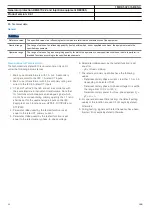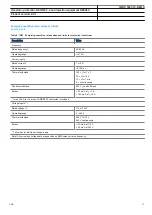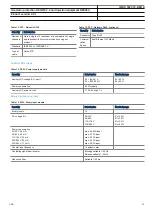
Integer to Boolean 16 conversion with logic node
representation ITBGAPC
SEMOD158421-5 v9
Integer to boolean conversion with logic node representation
function (ITBGAPC) is used to transform an integer which is
transmitted over IEC 61850 and received by the function to
16 boolean (logic) output signals.
Comparator for integer inputs INTCOMP
GUID-A93564FA-0017-4939-A9C1-095DA0FD9832 v1
The function gives the possibility to monitor the level of
integer values in the system relative to each other or to a
fixed value. It is a basic arithmetic function that can be used
for monitoring, supervision, interlocking and other logics.
Comparator for real inputs REALCOMP
GUID-E17A88D7-D095-4F36-9CD5-64EBFD2A1DEA v1
The function gives the possibility to monitor the level of real
value signals in the system relative to each other or to a fixed
value. It is a basic arithmetic function that can be used for
monitoring, supervision, interlocking and other logics.
14. Monitoring
Measurements CVMMXN, CMMXU, VNMMXU, VMMXU,
CMSQI, VMSQI
M12024-3 v9
The measurement functions are used to get on-line
information from the IED. These service values make it
possible to display on-line information on the local HMI and
on the substation automation system about:
• measured voltages, currents, frequency, active, reactive
and apparent power and power factor
• measured analog values from merging units
• primary phasors
• positive, negative and zero sequence currents and
voltages
• mA, input currents
• pulse counters
Supervision of mA input signals
M16054-3 v2
The main purpose of the function is to measure and process
signals from different measuring transducers. Many devices
used in process control represent various parameters such as
frequency, temperature and DC battery voltage as low current
values, usually in the range 4-20 mA or 0-20 mA.
Alarm limits can be set and used as triggers, e.g. to generate
trip or alarm signals.
The function requires that the IED is equipped with the mA
input module.
Disturbance report DRPRDRE
M12153-3 v13
Complete and reliable information about disturbances in the
primary and/or in the secondary system together with
continuous event-logging is accomplished by the disturbance
report functionality.
Disturbance report (DRPRDRE), always included in the IED,
acquires sampled data of all selected analog input and binary
signals connected to the function block with a maximum of
40 analog and 352 binary signals.
The Disturbance report functionality is a common name for
several functions:
• Event list
• Indications
• Event recorder
• Trip value recorder
• Disturbance recorder
• Settings information
The Disturbance report function is characterized by great
flexibility regarding configuration, starting conditions,
recording times, and large storage capacity.
A disturbance is defined as an activation of an input to the
AnRADR or BnRBDR function blocks, which are set to trigger
the disturbance recorder. All connected signals from start of
pre-fault time to the end of post-fault time will be included in
the recording. Disturbance record will have visible settings
from all function instances that are configured in the
application configuration tool.
Every disturbance report recording is saved in the IED in the
standard Comtrade format as a reader file HDR, a
configuration file CFG, and a data file DAT. The same applies
to all events, which are continuously saved in a ring-buffer.
The local HMI is used to get information about the recordings.
The disturbance report files can be uploaded to PCM600 for
further analysis using the disturbance handling tool.
Event list DRPRDRE
M12412-6 v8
Continuous event-logging is useful for monitoring the system
from an overview perspective and is a complement to specific
disturbance recorder functions.
The event list logs all binary input signals connected to the
Disturbance recorder function. The list may contain up to
1000 time-tagged events stored in a ring-buffer.
Indications DRPRDRE
M12030-3 v6
To get fast, condensed and reliable information about
disturbances in the primary and/or in the secondary system it
is important to know, for example binary signals that have
changed status during a disturbance. This information is used
in the short perspective to get information via the local HMI in
a straightforward way.
There are three LEDs on the local HMI (green, yellow and
red), which will display status information about the IED and
the Disturbance recorder function (triggered).
The Indication list function shows all selected binary input
signals connected to the Disturbance recorder function that
have changed status during a disturbance.
1MRK 502 074-BEN A
Generator protection REG670 2.2 and Injection equipment REX060,
REX061, REX062
Product version: 2.2.1
ABB
35
















































